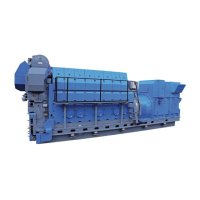Description
This guideline specifies the basic demands made
on cooling water for cooling tower operation.
Should the cooling tower manufacturer make fur-
ther demands on the water quality, these require-
ments must, by all means, be observed.
Moreover, it must be taken into consideration that
additional demands will be made on the water qual-
ity depending on the material of the coolers, which
are applied with water. Additional requirements for
the cooling water made by the cooler manufacturer
must also be observed.
General
The raw water system with cooling tower re-cooling
concerns an open circulation system, which dissi-
pates the heat absorbed from the water by evapo-
ration into the cooling tower. This results at the
same time in a continuous water loss due to evapo-
ration. In order to restrict the incurring salt concen-
tration, a certain water amount must permanently
be topped as additive water.
Water losses due to evaporation and blowing down
(depending on the additive water quality) may
amount up to 3 % of the circulating water quantity.
Blowing down
An increasing evaporation loss results in a higher
concentration of the salts and the suspended sub-
stances in the water and, therefore, in an increasing
tendency to corrosion and the formation of deposits
in the system. In addition, the raw water absorbs
impurities from the ambient air. Deposits have a
negative effect on the heat dissipation in the coolers
and the control system function.
In order to avoid excessive concentration, a part of
the thickened circulating water must be removed
from the circuit and be replaced by less concentra-
ted additive water. Blowing down has a regulating
effect on the concentration constituents of the cir-
culating water. The amount of the water to be
exchanged depends on the water quality and has to
be chosen as to ensure constant compliance with
the limit values specified for the circulating water
(see Table 1).
Additive water
The system water losses caused by blowing down,
evaporation or leakages must be replaced by con-
tinuous additive water topping during operation.
The required amount of additive water depends on
the quality of the additive water and the climatic site
conditions.
Certain demands have to be made on the additive
water quality, which is based on the requirements
for circulating water taking the concentration degree
into consideration. If the required water quality can-
not be achieved, the water has to be treated chemi-
cally (e.g. softening or hardness stabilisation) or
mechanically, if necessary. Otherwise
• deposits due to precipitation of hardly soluble
salts,
• sediments of disperse solid substances,
• corrosion,
• growth of micro organisms
are to be expected.
The cooling tower should, at least, be run with a
concentration by factor 2. Higher concentrations
are, in general, more economic. In order to permit
this, the content of substances must not exceed
half of the amount of the contents permitted for cir-
culating water. For the absolute minimum require-
ments,
see Table 1.
Water treatment
Depending on the water quality, various treatment
processes come into consideration:
• Decarbonisation, acid injection
• Desalinisation
• Cooling water conditioning (chemical treatment).
By using special chemicals, so-called stabilisers
and conditioners, deposits and corrosion in the
cooling water circuit can largely be controlled.
These means permit operation at increased con-
centration and, therefore, a reduction of the
required additive water.
When using chemical additives for cooling water
conditioning, the cooling tower manufacturer is to
be contacted.
MAN Diesel & Turbo
1699250-5.0
Page 1 (2)
Quality of raw-water in cooling tower operation
(additive and circulating water)
B 13 00 0
L28/32S, L27/38S, L23/30S, L21/31S, L16/24S, V28/32S, L16/24, L21/31,
L23/30H, L27/38, L28/32H
2008.10.27

